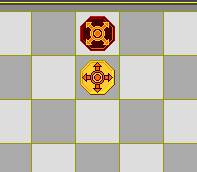Page 6 of 33
Rotary
 | The idea for Rotary came from Ploy, a proprietary game (3M) in the seventies. In this game the number of directions a piece could choose from, also determined its maximum range. This had two major drawbacks: first of all the limited and different ranges of the pieces did put a strain on clarity. A simple look at the directions was not enough: one constantly had to check the different ranges. The second flaw was even worse. By increasing the range with the number of directions, the strong pieces became even stronger, the weak even weaker. Moreover, three pieces of pathetic weakness - one step in one possible direction - were outnumbered by six very strong pieces, each able to go up to three steps in three possible directions. |
Although the weak ones were compensated by their right to rotate in the same turn, I've seldom seen a better example of internal imbalance in a game. But I also saw the possibility of a complete and consistent set of long-range pieces, to provide for clarity, separated by very orthodox pawns, to bring at least some strategy to a system of capricious tactics.
 | Once the idea was there, implementation was simple.
|
The pieces follow a logical sequence. All are subject to the following rules:
- A piece may, at the cost of a turn, rotate on its place, provided this effectuates a change in orientation.
- A piece may move one square in any of its directions and rotate, but only after the move, as part of the same turn.
- A piece may move any distance in any of its directions, but if it moves more than one square, it loses the right to rotate in the same turn. The only exception is the Scythe that has the right to rotate in the same turn regardless of the length of its move.
|
Strategy
The strategic implications of the pawn structure differ little from Chess. Apart from this, it is difficult calculate deep in the game's rather capricious tactics, and in consequence also to make a specific overall plan.
The pieces are of roughly equal strength, but differ rather dramatically in timing. The forward oriented Axe, for instance, has no immediate possibility for retreat, so its encounter with an opponent's pawn structure should be avoided. The Axe usually becomes active in the later stages of the game when the number of pawns has reached saver levels.
The Rook, to a lesser degree, encounters the same problems. The best orientation is usually with its middle direction obliquely forward or even sideways, to ensure the possibility of a retreat.
The Trident can be brought into play in an earlier stage. Its directions are rather roundabout ensuring a greater flexibility.
The Scythe is the opening piece par excellence. Its greatest joy is penetrating behind the opponent's pawn structure and finding the pieces, from its opponent's point of view, in precisely the wrong orientation. The amount of havoc a Scythe can create in these circumstances is unbelievable!
External links
- Rotary @ ZillionsRotary has been implemented on the Zillions game machine.
- Jogre - realtime playJogre (Java Online Gaming Real-time Engine) will feature Rotary soon.
- Rotary @ BoardGameGeek - Forum
Rotary © MindSports
No applet
